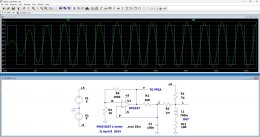john larkin
2024-04-09 00:17:15 UTC
I can build this into my new programmable inductor module, for
self-test. With a 1% cap, it should be plenty good. L range will be
750 mH down to maybe 10 mH, part of simulating solenoids and torque
motors and such.
If I add a switch to open R3 and run some current through R1, it can
measure series resistance too.
Loading Image...
https://www.dropbox.com/scl/fi/gojlqxj23r4m57ke9jhui/Ind_Meter_1.asc?rlkey=if40kmtiz49gp62bacfvju3uv&dl=0
self-test. With a 1% cap, it should be plenty good. L range will be
750 mH down to maybe 10 mH, part of simulating solenoids and torque
motors and such.
If I add a switch to open R3 and run some current through R1, it can
measure series resistance too.
Loading Image...
https://www.dropbox.com/scl/fi/gojlqxj23r4m57ke9jhui/Ind_Meter_1.asc?rlkey=if40kmtiz49gp62bacfvju3uv&dl=0